Art Nouveau Stencilled wallcoverings (2019)
Fifty six important stencilled textiles, grasspapers and wallcoverings from MoDA’s Silver Studio Collection are now available to students and researchers, following the completion of a major conservation project. We are grateful for the support of the Association of Independent Museums (AIM) who made this project possible.
the problem
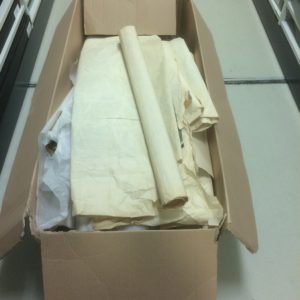
stencilled papers stored rolled in an oversized non-archival cardboard box
The stencilled materials were originally stored roughly rolled in the Silver Studio. There they were exposed to atmospheric and physical damage over a long period (between 1890 and 1960). Soot from coal fires, dust, damp and general wear and tear resulted in staining, creasing and tearing of many of the items. Following removal from the Silver Studio, this collection of materials was piled into an oversized cardboard box. They ultimately came to rest in the environmentally controlled stores at MoDA, where further deterioration was, at least, inhibited.
The contents of the box remained largely unexplored until MoDA’s conservator Emma Shaw surveyed the materials in early 2018 with the help of Naoko Nomoto. She concluded that the majority of the stencilled items could be made accessible to students researchers through a conservation and re-housing programme. A number of items were extremely long, and would always need to be stored rolled, so a suitable housing system would need to be devised for them. Others could be stored flat in boxes.
the proposed solution
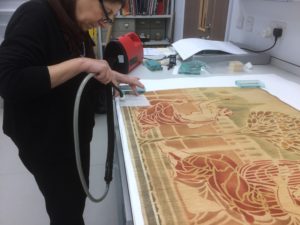
Michal cleaning a stencilled textile using a museum vacuum and special soft brush attachment.
With the help of funding from AIM, we employed freelance paper conservator Michal Sofer to carry out a series of conservation treatments, and then to re-house the materials appropriately so that they could be accessed easily from our stores.
conservation
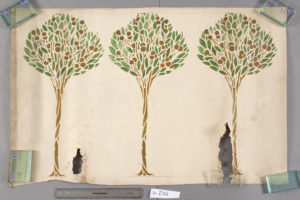
Stencil on paper before treatment
Michal used a range of conservation techniques appropriate to the particular materials and media that she found within the collection.
These treatments included gentle dry cleaning, removal of surface mould, humidification and flattening (of paper items), paper tear repairs and infills of losses. Some paper stencils, like this fruit tree border actually underwent all of these treatments.
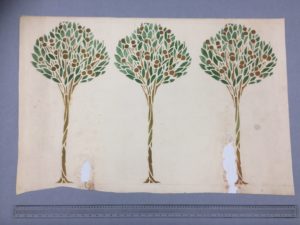
Stencil on paper after treatment
Research into appropriate methods for treatment of the grasspaper wallcoverings was taken from a wide range of conservation resources. These included the experiences of ethnographic conservators specializing in basketry weaving and unprocessed grass fibres.
Grasspaper is made by weaving ‘grass’ stems together with a cotton thread (usually the grass stems comprise the ‘warp’, and the thread, the ‘weft’), this woven layer is then adhered to a lightweight paper backing.
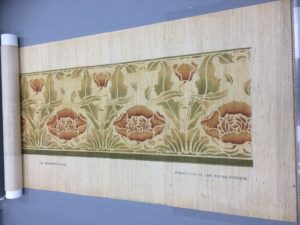
Grasspaper frieze after treatment being rolled onto archival roll. (cleaned using museum vacuum)
The weaving element of the construction of the material has often lead to it being called ‘grasscloth paper’. It is thought that the Silver Studio’s grasspaper supply may have been sourced in Japan, but the manufacture of grass cloth paper is known to have taken place in China historically.
Most of the grasspapers from this part of MoDA’s collection benefited from cleaning using a museum vacuum with a soft brush attachment, and the application of local paper repairs to the verso in particularly damaged and vulnerable area.
re-housing the items
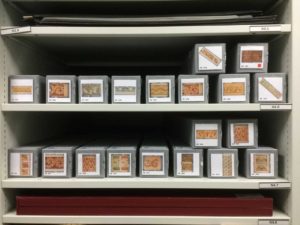
Store shelving holding two shelves of rolled stencils and one solander box containing flat stencils on paper.
Emma and Michal decided how to re-house the items according to the size and format of each one:
-
-
- they rolled large grasspaper and textile samples onto archival rolls. These were then placed into telescopic archival boxes and labelled individually.
- they flattened smaller paper items and stored them in archival polyester pockets in solander boxes.
-
Results of the project
The stencils are now protected from future physical damage. They are:
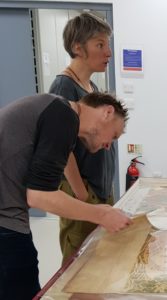
July 2019. Dr Vesna Lukic and Dr Thomas Kador were the first academic staff to see the newly conserved items.
- protected from physical and environmental damage by the archival housing systems designed for this purpose
- organised and labelled clearly within the environmentally controlled museum store
- fully accessible, with accession details and project records integrated into the museum database
These stencilled materials are now ready to be used by students and researchers from Middlesex University and elsewhere.
We’re looking forward to seeing how these materials are used in creative projects in the future.
